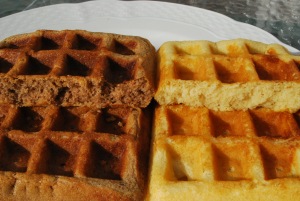Early last fall one of my coworkers surprised me by bringing in two large buckets filled with mesquite pods she had collected from her property. She knew that I have a baking habit and thought I might be able to use the pods. All I had to do was take them to get ground into flour/meal. In Tucson we have a great organization called Desert Harvesters who set up at several locations around town in the fall to grind mesquite pods. Sadly, I managed to miss two different weekends when they had set up to mill the pods. In the end, the lovely pods that I had been gifted became infested with some sort of bug while sitting in my garage. I can not tell you how wasteful I felt. I had such a great opportunity, and I blew it.
Fortunately, acquiring mesquite flour isn’t terribly difficult in Tucson. Mesquites are the most common shrub/tree in the desert Southwest. The pods, ground into a flour or meal, have been a part of local cuisine for hundreds of years. In fact, several studies have show that, like many other desert foods, the sweetness of the meal is deceiving. In truth, mesquite flour can be wonderful for controlling blood sugar levels. Obviously, this is a boon to people with diabetes, but I think it’s really great for all of us.
I picked up some flour from my beloved Native Seeds/SEARCH. It is also available here, here and here. It’s a little pricey, but is used in smaller quantities and in combination with regular flour.
These pancakes have no sugar in the batter. In the picture, they are show with honey as a topping. For the gluten-free folks out there, just substitute your favorite gluten free flour mix for the all-purpose portion of this recipe and you’re all set!
Mesquite Flour Pancakes
- 1 2/3 cups all-purpose flour
- 1/3 cup mesquite flour
- 1/3 teaspoon salt
- 1 teaspoon baking powder
- 2 cups milk, maybe slightly less
- 2 eggs, well-beaten
- 1/2 stick butter, melted
In a large bowl sift together the all-purpose flour, mesquite flour, salt and baking powder.
In a separate, smaller bowl whisk together the eggs, butter and milk. Add the wet ingredients to the dry ingredients and mix until just combined. There will probably be some lumps, but if you mix too much your pancakes will get tough.
Pour your batter onto a hot , lightly greased skillet in 2 T increments for silver dollar sized pancakes or in 1/4 c dollops for full-sized pancakes.
Serve with warm honey, maple syrup or fruit preserves.
___________________
UPDATED 1.7.09:
Check out Peter’s comment below if you are planning to make these gluten free. The picture below is his and shows the difference between waffles with mesquite flour subbed in using his method and plain GF flour waffles (looks like moslty just color to me). He offers some experience with GF flour mixtures that I don’t have, hopefully it helps!











 be able to get down in there to measure temperature/cooking stage of the candy.
be able to get down in there to measure temperature/cooking stage of the candy.



















